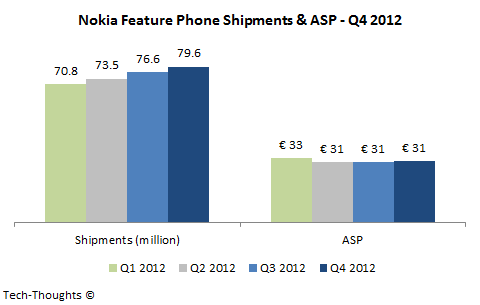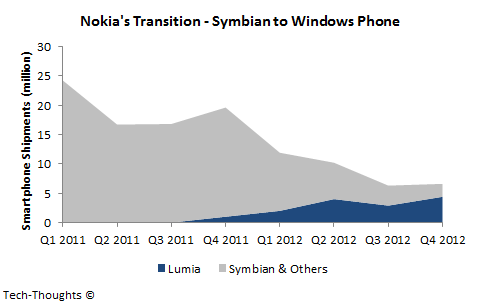Nokia's stock price just jumped by more than 15% after their preliminary results for Q4 2012 delivered better than expected profitability. Nokia has also claimed that Lumia sales were "better than expected", but as the shipment chart above shows, that seems to be caused by low expectations. This essentially confirms my hypothesis that Lumia 920 sell-outs were a function of supply, not demand.
As I expected, Nokia did post strong sequential growth in Lumia shipments, but that was primarily driven by the WP8-driven shipment crash in Q3. Lumia shipment growth from Q2 to Q4 was just 10%, which shows that demand for Windows Phone devices remains considerably weak compared to the broader market. In addition to this, the market for Symbian smartphones continues to shrink rapidly and Nokia's position in the smartphone market looks considerably weak. However, Nokia's pricing decisions seem to have boosted Nokia's smartphone ASP by 17% to approximately €180.
It is important to note that these smartphone figures do not include Nokia's Asha full touch portfolio, which Nokia has attempted to use in order to boost their smartphone figures. Nokia has claimed that research houses, like IDC, have classified Nokia's Asha full touch range as full smartphones. However IDC denied Nokia's claims in an interview with a leading Indian Business Daily:
"IDC has never classified Asha series as smartphones," Melissa Chau, research manager for smartphones and tablets at IDC, says. "Somebody from IDC did say that Asha series provided smartphone-like experience, but never classified it as smartphone," she tells ET over phone from Singapore.Based on this, and the fact that the Asha range is still reported under Nokia's "Mobile Phones" division and not its "Smart Devices" division, it makes sense to bunch them together with other feature phones:
Nokia has been marketing a few of its Asha devices as "smartphones", which has helped it post modest QoQ growth in its feature phone portfolio. However, the ASP has remained roughly flat at €31. However, Nokia's Asha full touch portfolio is essentially a "Tweener" category between the feature phone and smartphone segment, and I consider it a temporary market opportunity while prices of low-end Android smartphones continue to drop. Using the Asha full touch range isn't s sustainable long-term strategy against low-priced Android vendors.
Nokia's Q1 2013 outlook is very similar to the one I had laid out in my last analysis. Q1 is traditionally a far weaker quarter than Q4, which should cause another crash in Lumia sales.
Review of Nokia's transition to Windows Phone
On February 11th, 2011, Stephen Elop announced Nokia's decision to move their primary smartphone platform from Symbian to Windows Phonem with a stated "two year transition" period. We are nearly at the end of that period and Nokia's smartphone shipments have dropped from 24.2 million in Q1 2011 to 6.6 million in Q4 2012, with just 4.4 million Lumia shipments. I think at this point, it is fairly safe to state that Nokia's Windows Phone strategy has failed.










